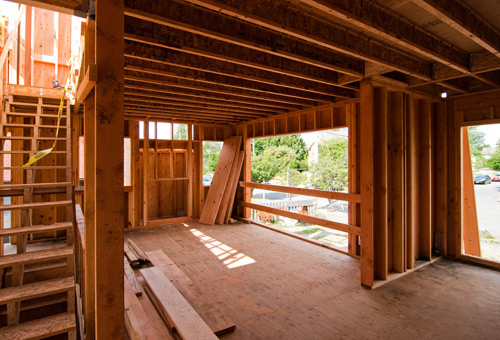
[All photos by BUILD LLC]
A residential project of ours is currently being framed, which means that we’re spending lots of time on site checking the structure in relation to our design intent. Framing is tricky – it sets the stage for everything else about the project and an overlooked detail in framing can have serious repercussions with the finished product later. There’s a handful of tips and tricks that separate crisp, modern architecture from ordinary projects; we’ve rounded up our top 10 bullet points along with some recent site photos. Let us know what you know.

1. Make sure the framer understands your custom details; a little due diligence goes a long ways to saving the bottom line. Nobody wants to remodel the remodel.
2. Make sure that the plumbers, electricians and mechanic installers don’t have a chainsaw in their truck. Sub contractors that simply hack-away at the framing to fit their systems into the design will end up compromising the structural integrity as well as the design aesthetics. Good sub-contractors use communication and negotiating rather than logging equipment.

3. Think through alignment issues; door and window heads should line up inside (ideally with a sweet no-casing drywall wrap) as well as line up outside, which means the framing needs to offset so that the finish conditions align. Also, sometimes you need to offset adjacent framing so that when different types of finishes are added to surfaces, you still get alignment.
4. Look for opportunities to recess/conceal framing hardware, like straps, brackets, etc. that give you headaches when going for finish because they interfere with a smooth modern finish.

5. Take the appropriate time on the very last round of pick-up framing to shim/ shave where needed for a flat finish.
6. Place blocking wherever you might suspect you need it- both for things like bath hardware (picture your six-year old hanging on the t.p. holder) and for other things like door or recess light tracks that you may want to recess into the sheetrock. Sometimes, we’ll plywood sheath entire walls if we’re unclear about hooks, shelving, etc.

7. Take time to adjust joist lay-out before the floor is framed to ensure that the can-lights will hit the lines you intend. Take time to block out/ adjust framing for venting, future speakers, etc. so that they’ll align with can lighting or other devices.
8. There are often different blocking needs in modern projects; for instance we design flush base details and low horizontal outlets; each of these requires a band of low blocking around the room.

9. Triple check framing at any place where cabinetry or other tricky installs will meet a wall or ceiling finish.
10. Layout basic devices ,fixtures and appliances ASAP; this will help determine duct runs, waste pathways, and troublesome areas.






